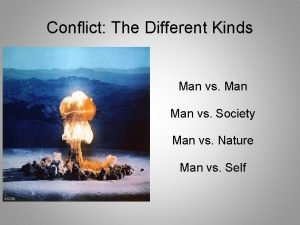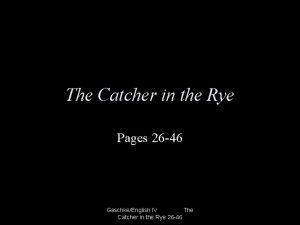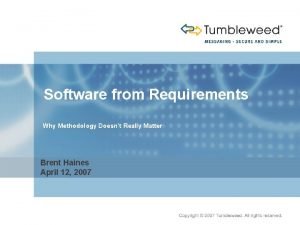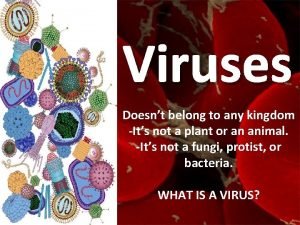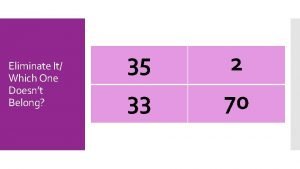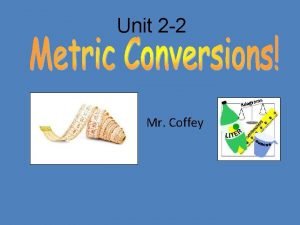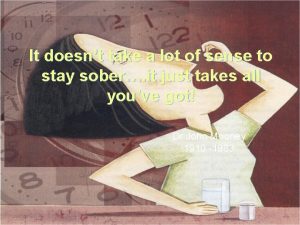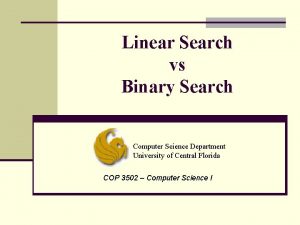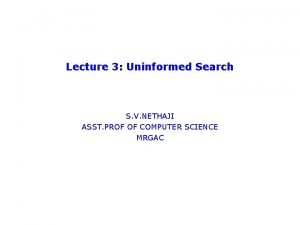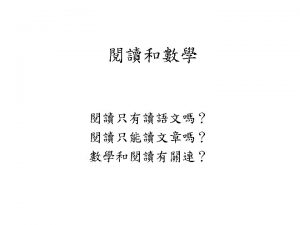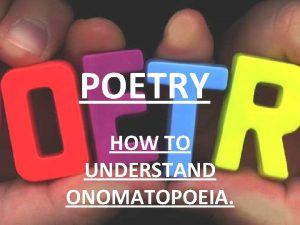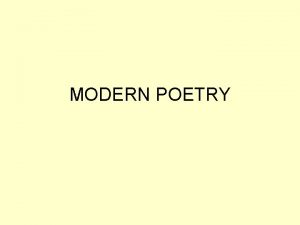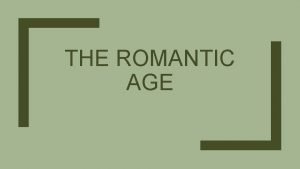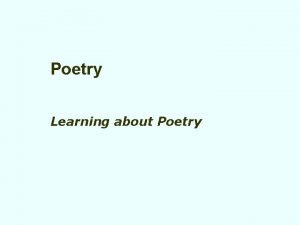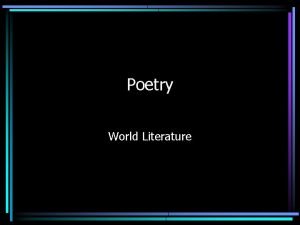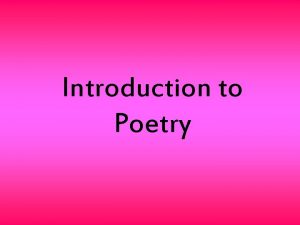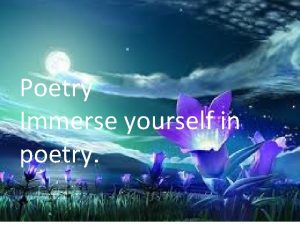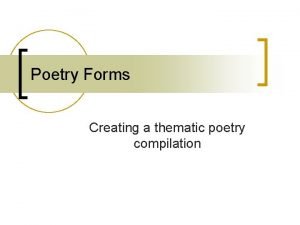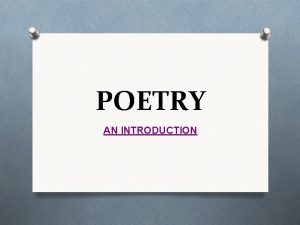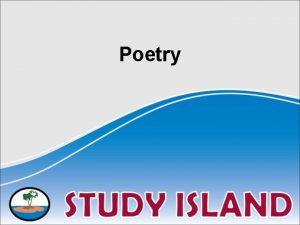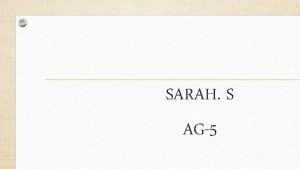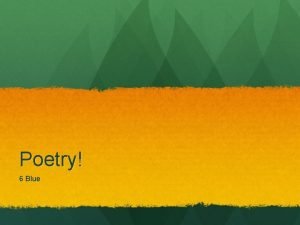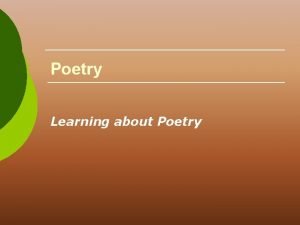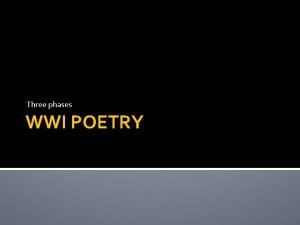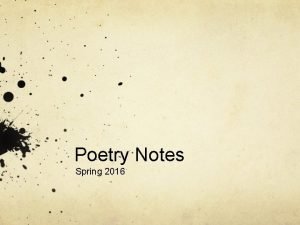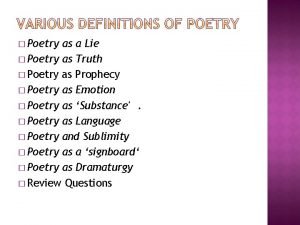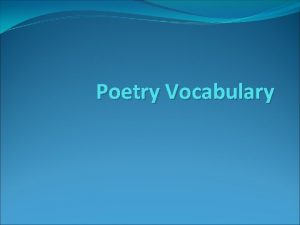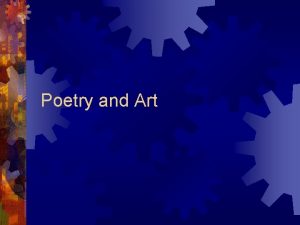POETRY YangWanLi A man doesnt go in search






























- Slides: 30

POETRY

Yang-Wan-Li “A man doesn’t go in search of a poem— the poem must come to him. ”

Poetry • A genre of literature that expresses ideas, feelings, or tells a story in a specific form (usually using lines and stanzas)

Key Elements of Poetry form n speaker n sound n imagery n figurative language n

FORM n the way a poem looks on the page n written in lines are grouped into stanzas n couplet-2 line stanzas n triplet-3 line stanzas n quatrain-4 line stanzas n n structured form-stanzas repeat in a pattern free verse-have no regular pattern

“Tree House” by Shel Silverstein A tree house, a free house, A secret you and me house, A high up in the leafy branches Cozy as can be house. A street house, a neat house, Be sure and wipe your feet house Is not my kind of house at all— Let’s go live in a tree house.

“The Red Wheelbarrow” by William Carlos Williams so much depends upon a red wheel barrow glazed with rain water beside the white chickens

SPEAKER n the voice that relates the story or ideas n n may be the poet himself may be a character or voice created by poet

4 ways to create SOUND Rhyme n. Rhythm n. Repetition n. Onomatopoeia n

SOUND • rhyme: repetition of similar sounds • • • end rhyme-words rhyme at the ends of line internal rhyme-words rhyme within one line rhyme scheme-organized pattern of rhymes by analyzing the last word in each line (ABCB, AABB) “To You” by Langston Hughes To dream of vast horizons of the soul Through dreams made whole, Unfettered free—help me! A A B

SOUND, cont. n rhythm: pattern of stressed & unstressed syllables in each line; beat created by the sounds of the words “There’s a Bug on the Teacher” by Kalli Dakos There’s a bug on the teacher, And it’s crawling on her shoe, What will she do? It’s crawling on her shoe! There’s a but on the teacher, And it’s crawling on her pants, Had us in a trance, That bug on her pants. There’s a bug on the teacher, And it’s crawling on her shirt, I hope it won’t hurt, That bug on her shirt. There’s a bug on the teacher, And it’s crawling on her neck, Everyone check, It’s crawling on her neck. There’s a bug on the teacher, And it’s crawling on her nose, Why do you suppose It’s tickling her nose?

SOUND, cont. n Repetition: sounds, words, phrases, or lines repeated to emphasize an idea or feeling n n n alliteration: repeating of beginning consonant sounds assonance: repeating of vowel sounds consonance: repeating of consonant sounds anywhere in words “It’s Dark in Here” by Shel Silverstein I am writing these poems From inside a lion, And it's rather dark in here. So please excuse the handwriting Which may not be too clear. But this afternoon by the lion's cage I'm afraid I got too near. And I'm writing these lines From inside a lion, And it's rather dark in here.

SOUND, cont. n Onomatopoeia: sound words (boom, crack, bang) from “The Bells” by Edgar Allan Poe Hear the sledges with the bells— Silver bells— What a world of merriment their melody foretells! How they tinkle, In the icy air of night!

IMAGERY n imagery: language that appeals to the 5 senses—sight, hearing, smell, taste, touch

FIGURATIVE LANGUAGE n 4 types: n n Simile Metaphor Analogy Personification

FIGURATIVE LANGUAGE, cont. n n simile: comparison using “like” or “as” metaphor: direct comparison; saying something is something else “Fame is a bee” by Emily Dickinson Fame is a bee. It has a song -It has a sting -Ah, too, it has a wing.

FIGURATIVE LANGUAGE, cont. n analogy: comparison between 2 things that seem dissimilar to show ways they might be similar

FIGURATIVE LANGUAGE, cont. n personification : using human qualities to describe an animal or object

“Rain” by Shel Silverstein I opened my eyes And looked up at the rain, And it dripped in my head And flowed into my brain, And all that I hear as I lie in my bed Is the slishity-slosh of the rain in my head. I step very softly, I walk very slow, I can't do a handstand— I might overflow, So pardon the wild crazy thing I just said— I'm just not the same since there's rain in my head.

A flea and a fly in a flue Were caught, so what could they do? Said the fly, "Let us flee. " "Let us fly, " said the flea. So they flew through a flaw in the flue. -Anonymous

Super Samson Simpson by Jack Prelutsky I am Super Samson Simpson, I'm superlatively strong, I like to carry elephants, I do it all day long, I pick up half a dozen and hoist them in the air, it's really somewhat simple, for I have strength to spare. My muscles are enormous, they bulge from top to toe, and when I carry elephants, they ripple to and fro, but I am not the strongest in the Simpson family, for when I carry elephants, my grandma carries me.

“The Germ” by Ogden Nash A mighty creature is the germ, Though smaller than the pachyderm. His customary dwelling place Is deep within the human race. His childish pride he often pleases By giving people strange diseases. Do you, my poppet, feel infirm? You probably contain a germ.

Types of Poems n n n Lyric Narrative Cinquain Haiku Acrostic

lyric n short & written in 1 st person n n expresses an emotion or idea OR describes a scene n do NOT tell a story n are often musical

narrative n n poem that tells a story longer than lyric in order to establish characters & a plot

cinquain n 5 line poem with 22 syllables n n n 2 syllables 4 syllables 6 syllables 8 syllables 2 syllables How frail Above the bulk Of crashing water hangs Autumnal, evanescent, wan The moon.

you try it…cinquain Line 1 (2): 1 noun Line 2 (4): 2 adjectives Line 3 (6): gerunds (verb + -ing) Line 4 (8): 1 related phrase or sentence Line 5 (2): 1 noun (a synonym of NOUN in 1) Winter Cold and icy Skating, sledding, skiing Waiting for a snow day to play Season

try it again…cinquian n n (2) title & topic (4) description of topic (6) some action about the topic (8) feelings about topic (2) synonym to the topic

haiku n Japanese poem written in 3 lines n n n 5 syllables 7 syllables 5 syllables An old silent pond… A frog jumps into the pond… Splash! Silence again.

acrostic n n topic is written vertically first letter of each line forms a word/phrase lines describe the topic NAME POEM from the beginning of the year
 Man vs man meaning
Man vs man meaning Why doesn't holden throw the snowball
Why doesn't holden throw the snowball Doesnt really matter
Doesnt really matter What goes up and doesnt come down
What goes up and doesnt come down What kingdom do viruses belong to
What kingdom do viruses belong to Giann porn
Giann porn Gfletchy 3 act tasks
Gfletchy 3 act tasks King henry doesn't like chocolate milk
King henry doesn't like chocolate milk Doesnt tense
Doesnt tense Stuart gitlow
Stuart gitlow Blind search
Blind search Federated search vs discovery
Federated search vs discovery èinterest
èinterest Federated search vs distributed search
Federated search vs distributed search Informed and uninformed search in artificial intelligence
Informed and uninformed search in artificial intelligence Https://images.search.yahoo.com
Https://images.search.yahoo.com Best first search in ai
Best first search in ai Heuristik
Heuristik Video.search.yahoo.com
Video.search.yahoo.com Video.search.yahoo.com search video
Video.search.yahoo.com search video Advantages and disadvantages of bst
Advantages and disadvantages of bst Linear search vs binary search
Linear search vs binary search Images.search.yahoo
Images.search.yahoo Cognitive search engine
Cognitive search engine Which search strategy is called as blind search
Which search strategy is called as blind search Yahoo shopping tw
Yahoo shopping tw Poetry wordsearch
Poetry wordsearch Metaphysical poetry
Metaphysical poetry Experimentation in modern poetry
Experimentation in modern poetry Lyric poetry tells a story
Lyric poetry tells a story Augustan age and romanticism
Augustan age and romanticism
